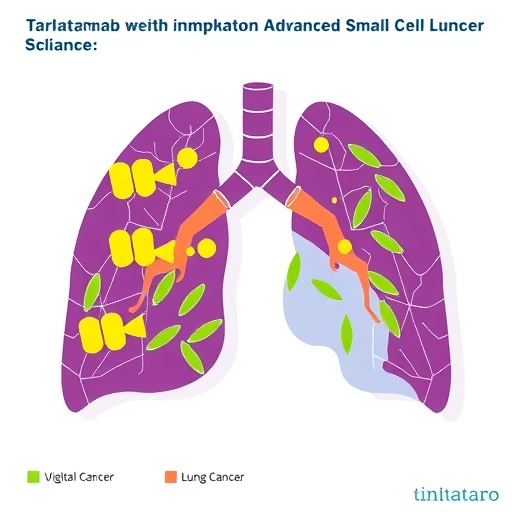In the world of oncology, where breakthroughs can define the course of treatment and patient outcomes, a recent study presents vital insights into the comparative effectiveness of Tarlatamab—a newly developed immunotherapy—against existing therapies for patients suffering from extensive-stage small cell lung cancer (SCLC). The findings, published in “Advances in Therapy”, illustrate a sophisticated analytical technique known as Matching-Adjusted Indirect Treatment Comparison (MAITC), shedding light on the potential benefits of Tarlatamab, especially for those who have endured two or more lines of prior therapy.
Tarlatamab, a bispecific T-cell engager, is engineered to target and direct T-cells towards cancer cells expressing DLL3, a protein often overexpressed in SCLC. This specificity has driven research interest as it suggests a new avenue for treatment in a patient population that has historically faced grim prognoses after exhausting conventional therapies. This study seeks to bridge the gap in understanding how Tarlatamab compares to existing treatment options in a real-world setting, specifically within the context of the English healthcare system, which places a premium on evidence-based practices.
The methodology deployed in this study not only enhances the reliability of the findings but also aligns with rigorous health economics standards. Researchers implemented the MAITC technique, which allows for the adjustment of various confounding factors that may bias outcome comparisons between different treatments. This methodological innovation is particularly important when dealing with indirect comparisons where head-to-head trials may not be feasible. The strength of this approach lies in its ability to provide a clearer picture of treatment effectiveness in a population that has already experienced multiple lines of therapy.
Data used in the research encompassed a range of clinical trials alongside real-world evidence, reflecting the diversity and complexity of the patient population. The analysis included pivotal studies that varied in design, size, and geographical context, highlighting the importance of ensuring that the comparisons made were as accurate and relevant as possible. This comprehensive approach enabled the researchers to account for factors such as baseline characteristics, disease stages, and prior treatment histories, thereby enhancing the robustness of their conclusions.
The results of the study reveal that Tarlatamab demonstrates promising efficacy in terms of overall survival and progression-free survival compared to traditional therapies such as chemotherapy and other targeted agents. In a landscape where survival rates for extensive-stage SCLC remain dishearteningly low, these findings illuminate a flicker of hope for patients who often feel like they are running out of options. The researchers advocate for further studies to confirm these findings, emphasizing the need for larger cohorts to validate the initial results.
While the initial outcomes are encouraging, the authors also noted the importance of considering the safety profile of Tarlatamab. Treatment-related adverse events can significantly impact patients’ quality of life, and it is crucial that healthcare providers balance potential benefits with the risk of toxicity. Early safety data suggest that Tarlatamab has an acceptable safety profile, but the long-term effects and the implications for specific sub-groups of patients warrant further investigation.
The economic implications of incorporating Tarlatamab into clinical practice are also critical. Healthcare systems are increasingly scrutinizing the cost-effectiveness of new therapies, particularly for diseases that have seen stagnant treatment advancements. As part of the discussion, the study hints at potential future analyses that could inform cost-effectiveness evaluations, providing invaluable insights for decision-makers in the healthcare sector.
Moreover, the authors highlight the broader ramifications of their findings. As the oncology landscape evolves with introduction of new therapies, it is essential that healthcare providers are equipped with the latest evidence to guide treatment decisions. This study not only fulfills that necessity for Tarlatamab but also sets a precedent for similar comparative effectiveness research in other therapeutic areas. Enhancing our understanding of how different treatments measure up against one another is critical for delivering personalized oncology care, thus improving clinical outcomes for patients.
In conclusion, the publication of this study marks a significant step forward in the ongoing battle against extensive-stage SCLC. As researchers unveil new therapies, patients and clinicians alike are eager to understand their place within current treatment paradigms. Tarlatamab’s potential to change the narrative for patients who have exhausted typical treatment avenues is considerable. Beyond its clinical implications, this research underscores the importance of methodological rigor in evaluating new therapies, ultimately pushing the field of oncology toward more informed and effective decision-making processes.
In the face of a devastating disease like extensive-stage small cell lung cancer, every piece of research that offers a glimmer of hope must be embraced. While further confirmation of these findings is needed, Tarlatamab’s promising efficacy against comparator therapies opens the door for an important conversation about novel immunotherapeutic strategies in oncology. The journey toward improving patient outcomes continues, but with studies like this, optimism can prevail amid adversity.
Subject of Research: Small Cell Lung Cancer Treatment Comparison
Article Title: Matching-Adjusted Indirect Treatment Comparison of Tarlatamab Versus Comparator Therapies in England in Patients with Extensive-Stage Small Cell Lung Cancer Who Have Received Two or More Prior Lines of Therapy.
Article References:
Takundwa, R., Suri, G., Dirnberger, F. et al. Matching-Adjusted Indirect Treatment Comparison of Tarlatamab Versus Comparator Therapies in England in Patients with Extensive-Stage Small Cell Lung Cancer Who Have Received Two or More Prior Lines of Therapy.
Adv Ther (2025). https://doi.org/10.1007/s12325-025-03376-4
Image Credits: AI Generated
DOI: 10.1007/s12325-025-03376-4
Keywords: Tarlatamab, Small Cell Lung Cancer, Indirect Treatment Comparison, Immunotherapy, Patient Outcomes, Comparative Effectiveness, Oncology.




